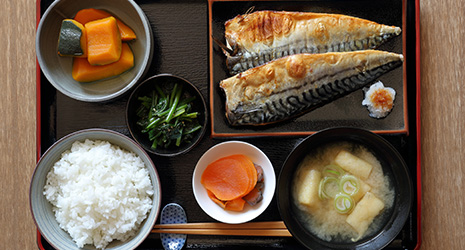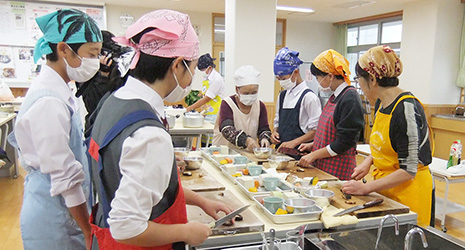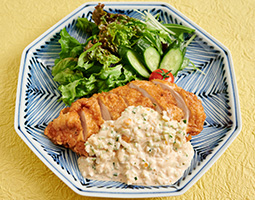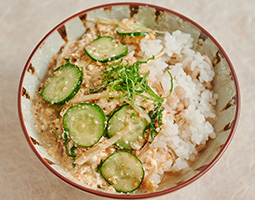February 2023
- English
- 日本語
Preserving Washoku for Future Generations

Example of a “one soup three dishes” (ichiju-sansai) meal 
Class run by a shokuiku teacher (center) instructing young people how to prepare the local cuisine of Miyazaki Prefecture

Chicken Nanban, fried chicken dipped in sweet vinegar, a regional cuisine of Miyazaki Prefecture, often served with tartar sauce 
Hiyajiru, a nutritious dish of cold soup served over barley rice, a regional cuisine of Miyazaki Prefecture

A range of initiatives are being undertaken in Japan to preserve and pass on to future generations “Washoku” (Japanese cuisine), which is inscribed on UNESCO’s Representative List of the Intangible Cultural Heritage of Humanity. We introduce some of those initiatives along with the regional cuisine of Miyazaki Prefecture, which will host the G7 Agriculture Ministers’ Meeting in April 2023.

“Washoku, traditional dietary cultures of the Japanese” was inscribed on UNESCO’s Representative List of the Intangible Cultural Heritage of Humanity almost a decade ago in December 2013. Japan’s proposal to UNESCO asserted that Washoku is a dietary culture as a social practice based on the Japanese spirit of “respect for nature.” Broadly speaking, “Washoku” has the following four distinctive characteristics.
(1) A Rich Variety of Fresh Ingredients and Respect for Inherent Flavors
Japan is a country that extends over a long area from north to south and is rich in nature such as oceans and mountains as well as countryside. Each region uses its own rich variety of local ingredients rooted in the communities, and cooking techniques and utensils that help to bring out the full flavor of these ingredients have been developed.
(2) Nutritional Balance that Supports a Healthy Diet
A diet based on “one soup three dishes” (ichiju-sansai)* is likely to have a good nutritional balance. Making good use of the “umami” of dashi soup stock** and fermented food makes it possible to realize a low-animal fats diet. It has helped Japanese people to live longer and prevent obesity.
(3) Expressions of the Beauty of Nature and Changing Seasons
One of the characteristics of Washoku culture is that it expresses the beauty of nature and the changing of the seasons by decorating dishes with seasonal flowers and leaves, and using furniture and dishware that match the seasons.
(4) An Intimate Relationship with Annual Events such as New Year
Japanese food culture is formed around its close ties to annual events. People in Japan have deepened bonds with family and community by sharing foods that are blessings from nature and by spending time eating together.
Preserving the Tradition of Washoku for Future Generations
According to the 2020 “Survey of Washoku Culture in the Dietary Habits of the Population” conducted by the Ministry of Agriculture, Forestry and Fisheries (MAFF) of the Japanese government, the image of Washoku held by some people is “good for one’s health” (48.9%) and “enable one to enjoy in-season produce” (44.9%), while the image held by others is “difficult to cook” (21.4%) and “takes time for preparation and clean-up” (19.5%).
MAFF is working with relevant ministries, agencies, and organizations to promote initiatives to preserve Washoku for future generations.
For example, annual training classes are being run for teachers, childcare workers, nutritionists, school dieticians, and others working in settings such as kindergartens and elementary schools to further their understanding of Washoku culture. The aim of the training is to develop key human resources (Washoku Culture Inheritance Leaders) in Japan who will engage in activities to pass on Washoku culture to the young generation and those involved in child rearing.
In addition, events to mark the tenth anniversary of the inscription of Washoku on UNESCO’s Representative List of the Intangible Cultural Heritage of Humanity will be held in 2023.
In 2020, MAFF launched the website “Uchino kyodoryouri (initially in Japanese only)”*** introducing the regional cuisines unique to each of Japan’s 47 prefectures. It functions as a database of information including the history and recipes of some 1,300 regional cuisines that have been selected by each prefecture.
In 2022, MAFF launched the website “Our Regional Cuisines — Beloved tastes and flavors we want to pass on to the next generation”**** to introduce regional cuisines to international audiences. The website is accessible in five languages (English, Simplified Chinese, Traditional Chinese, Spanish, and Thai), helping to disseminate information more widely both in Japan and around the world.
Regional cuisine of Miyazaki, host of the 2023 G7 Agriculture Ministers’ Meeting
Miyazaki Prefecture in Kyushu faces the Pacific Ocean and has an important role to play as a source of food supply because it is rich in nature and abundant in fish and agricultural produce. The prefectural capital of Miyazaki City will host the G7 Agriculture Ministers’ Meeting on April 22 and 23. During the meeting, various global agricultural issues including food security will be discussed.
One famous Miyazaki local cuisine is Chicken Nanban. Chicken Nanban is known to have originated in Nobeoka City. It is said that it was first prepared at a Western-style restaurant in Nobeoka City in the 1950s. In the 1960s, the dish became popular as a feast for the occasional family outing, and eventually became commonplace in school lunches, home cooking, and restaurant menus throughout the prefecture. Sprinkle flour (light flour) on chicken, dip in egg mixture, deep fry, and dip in amazu (sweet vinegar). After the chicken is floured, it is dipped in the egg mixture to make it easier to absorb the sweet vinegar after frying and to make it more palatable.

Another cuisine popular with locals is hiyajiru (dish of cold soup). Passed down from generation to generation, this dish was once a simple way for farmers engaged in strenuous physical labor in the summer months to nourish their bodies and refuel when they had neither the time nor the appetite to prepare something more elaborate. The broth consists of dried sardines ground up with miso paste and thinned with dashi soup stock; ingredients such as perilla leaves, cucumbers, or tofu may be added, and the mixture is served over cold barley rice.

Various efforts are being made by the Miyazaki Prefectural Government to preserve these cuisines for future generations.
For example, shokuiku***** teachers such as individuals engaged in the farming and fishing industry, nutritionists, and chefs hold classes for younger generations on traditional knowledge and cooking methods of regional and traditional cuisines that make the most of local ingredients.
* Ichiju-sansai is a meal consisting of rice as the staple food, main dish such as seafood, meat, and other animal products, side dishes such as vegetables, potatoes, and beans, alongside soup and pickles.
** Highlighting Japan June 2022, “The Appeal of Washoku Created by Umami” https://www.gov-online.go.jp/eng/publicity/book/hlj/html/202206/202206_01_en.html
*** https://www.maff.go.jp/j/keikaku/syokubunka/k_ryouri/
**** https://local-cuisine.maff.go.jp/en/
***** According to the Basic Act on Shokuiku, shokuiku is “the basis of a human life which is fundamental to intellectual, moral, and physical education, to be promoted for the purpose of educating people so that they may acquire knowledge about food and nutrition and ability to choose appropriate food and nutrition for their own sakes through various experiences, thus enabling them to adopt healthy dietary habits.”
Note: This article has been created with the consent of the Ministry of Agriculture, Forestry and Fisheries (MAFF) and the Miyazaki Prefectural Government, based on the materials published by them.

